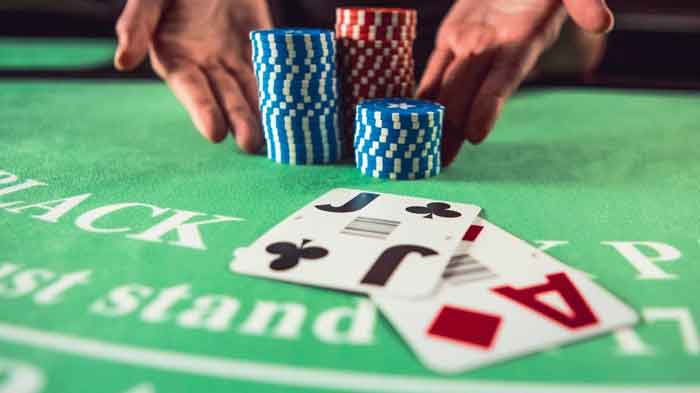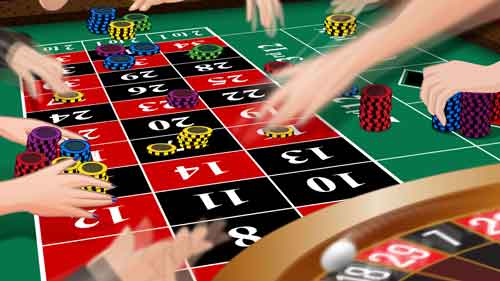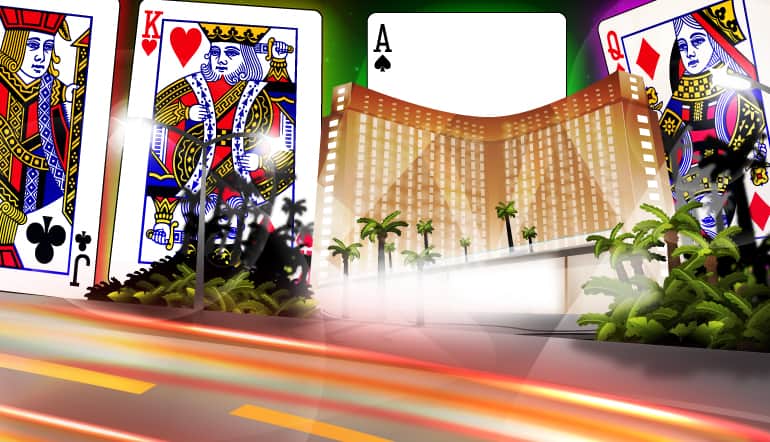Blackjack insurance is a side bet available to players when the dealer’s upcard is an Ace. In this scenario, players are presented with an interesting proposition: if you take the additional insurance bet, you can protect yourself in the event that the dealer’s hole card is a 10-value card a.k.a, the dealer has a blackjack. The insurance bet is offered at 50% of your original bet, and it pays 2:1.
Let's rewind for a second to understand why the insurance bet option is offered to players to begin with. Whether you’re playing blackjack in Atlantic City, at home with friends, or online, there are certain rules that determine the payout possibilities.
Blackjack is not simply a hand value of 21 – that would be too easy. Blackjack is a 2-card hand valued at 21. That means the hand must contain any 10-value card (10-Jack-Queen-King), as well as an Ace. In a 2-card blackjack hand, the Ace naturally counts as 11, not 1.
SCENARIO #1
Player bets $100
Player hand – 7 of hearts + King of diamonds = 17
Dealer hand – Ace of spades + ?
In this situation, you have a hand total (hand value) of 17, and the dealer is showing an Ace upcard. Were you to take the blackjack insurance option, you would place an additional bet valued at 50% of your original bet, $50. The blackjack insurance option will add $50 to your $100 for a total bet size up until this point of $150. What happens next? The rules for blackjack insurance bets will guide you.
Table of Contents
BLACKJACK INSURANCE RULES
Let's take a look at blackjack insurance rules based on Scenario #1 above, and a new scenario listed below. If the dealer peeks for blackjack and indeed has a 10-value card, things get very interesting.
Note, the Ace does not need to be accompanied by a Jack, Queen, or King for it to be blackjack – even a 10 will do. Now that the dealer has blackjack, your insurance bet pays 2:1. But, you only get that payout on the blackjack insurance bet ($50), not the $100 that you have bet on the original hand. That means you will receive the following blackjack insurance payout: 2X $50 = $100 profit + your original $50 returned.
Your total bet amounts to $150, and you will forfeit your $100 original bet since you lost that bet because the dealer has blackjack. Your total profit is calculated as follows: $100 profit (2:1 on $50) - $100 cost (original $100 bet that you lost) = $0.
The $50 that you placed on the blackjack insurance bet is not considered $50 profit, because you had that to begin with. The $100 that you won on the blackjack insurance pet cancels out the $100 that you placed on the original bet.
SCENARIO #2
Player bets $1,000
Player hand – King of hearts + Ace of diamonds
Dealer hand – Ace of clubs + ?
In this scenario, the stakes have been raised significantly. Not only has the player bet a substantial $1,000 on the original blackjack bet, the dealer is also showing an Ace upcard.
This is another perfect situation to consider the additional blackjack insurance side bet. To place this bet, the player is required to put down another $500. But what happens in this situation since the player already has blackjack?
If the dealer has a 10-value card, he/she also has blackjack. The player will win the blackjack insurance bet of 2:1 (2 x $500 = $1000 + the original $500 blackjack insurance side bet returned), and the player also has blackjack.
You may be curious to know whether the player will also win on his/her blackjack in addition to the blackjack insurance bet? This is a unique situation in which case the player and the dealer both have blackjack, resulting in a push. You still win their blackjack insurance side bet though.
In Scenario #2 if the dealer doesn't have blackjack, and you do, you will win your original bet, but lose the blackjack insurance side bet. Let's calculate the winnings and losses in this case:
Original bet of $1,000 wins with blackjack. If blackjack pays 3:2, the player wins 1.5 X $1000 = $1,500. However, the insurance side bet of $500 is forfeited.
Therefore, the total winnings amount to $1,500 - $500 = $1,000. If you're playing a 6:5 blackjack table, then things are a little worse for you. You will receive $6 for every $5 that you bet. In this case, your $1,000 blackjack bet wins you $1200. Subtract the $500 blackjack insurance side bet for a total haul of $700.
WHEN TO TAKE INSURANCE IN BLACKJACK?
There are two answers to this question. Technically, you will always be offered insurance (where available) when the dealer is dealt an Ace upcard. The blackjack insurance side bet is 50% of your original bet.
That's why it's so important to manage your bankroll effectively to maintain affordability with your betting. Now for the second answer to this question: never take insurance. This comes as a shock to many newbie blackjack players.
Why would the bet be available if it was strongly cautioned against? The answer lies in the probabilities of the dealer having a blackjack. To better explore this, we're going to take a step back and examine the odds of a 10-value card appearing in the dealer’s hand.
BLACKJACK INSURANCE ODDS
If you’re playing blackjack with a single deck of cards, there are 52 cards in total. Each suit has 13 cards. 4 cards from every 13 are 10-value cards. This means there is a 4/13 chance of the dealer having a 10-value card as the pocket card.
The ratio still holds if we multiply 4 x 10-value cards by 4 suits (clubs, hearts, spades, diamonds). You can do the math yourself: 4 x 4 = 16/52 = 4/13. Right, with that out of the way, there is a 30.8% chance of the dealer having a 10-value card in every deck. That also means your blackjack side bet has a 69.2% chance of losing every single time. Does that sound like a bet you would like to make?
Let's assume that the casino uses 6/8 decks of cards in a blackjack game. Sure, there are many more 10-value cards in the deck, but there are also many more non-10-value cards in the deck.
The ratio is the same, meaning that you are at a distinct disadvantage when placing the blackjack side bet. If 6 decks of cards are used, that means there are 6 x 52 cards in play.
That amounts to 312 cards, and with the dealer’s Ace showing, there are only 311 possible cards in play. For simplicity's sake, we have removed your 2 cards from the equation. In this case, if you played the blackjack insurance side bet every time, you would end up winning 96 times and losing 215 times. Overall, you will incur net losses.
While you may well be tempted to take the blackjack insurance side bet, don’t. It’s not a bet that’s going to pay off over the long-term. It’s improbable that the dealer will have a 10-value card every time an Ace upcard is showing and the cost of the blackjack insurance side bet is 50% of your original bet.
The disadvantage with this bet has been evaluated at -7.39%, meaning that the house edge just went from about 0.5% with perfect blackjack strategy to odds worse than American Roulette with its 00 at 5.29%. Rather save your money and stick to basic blackjack strategy and you’ll be much better off.















